Abstract
This study employs a prospective design to examine possible personality, drug use, stressful life event, and social support-related variables associated with the onset of a depressive episode in a cohort of psychoactive drug using young adults. Two waves of data, collected one year apart, were available on 942 individuals. Cases (n = 62) were free of depressive symptoms at time 1 but reported significant symptomatology at time 2 as measured by the depression subscale of the Brief Symptom Inventory. Controls (n = 490) were those free of depressive symptoms at both time points. In multivariate analyses, users of the central nervous system depressant methaqualone had a nearly four-fold elevated risk for depressed mood as compared to nonusers. Additional risk factors significant after multivariate adjustment included lower self-esteem at time 1 and negative life events. These results highlight the multifactorial nature of depressive symptomatology.
Full text
PDF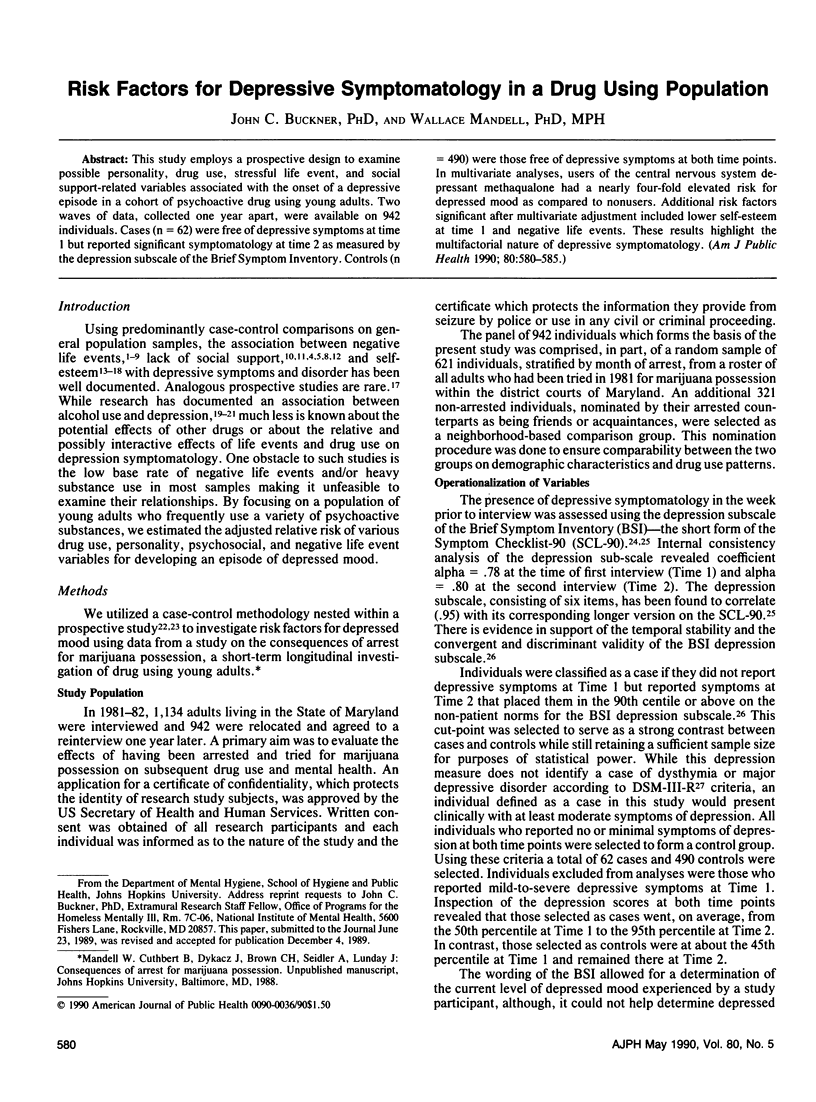
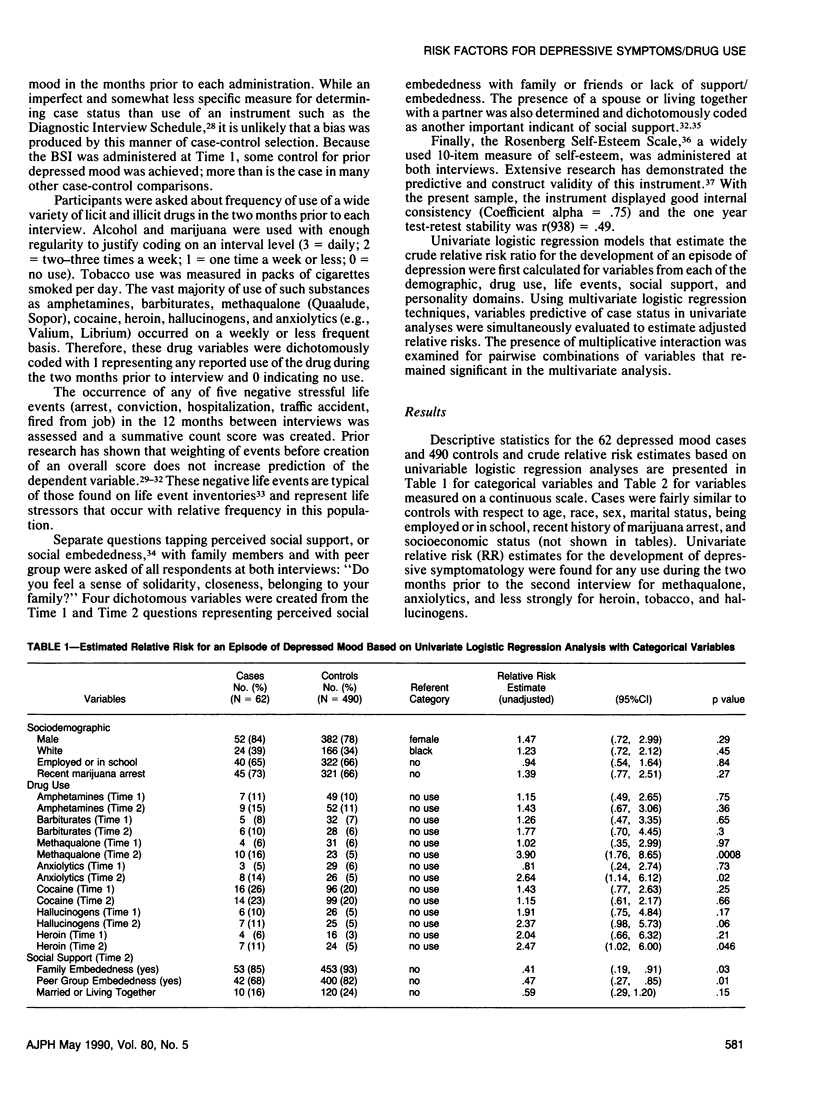
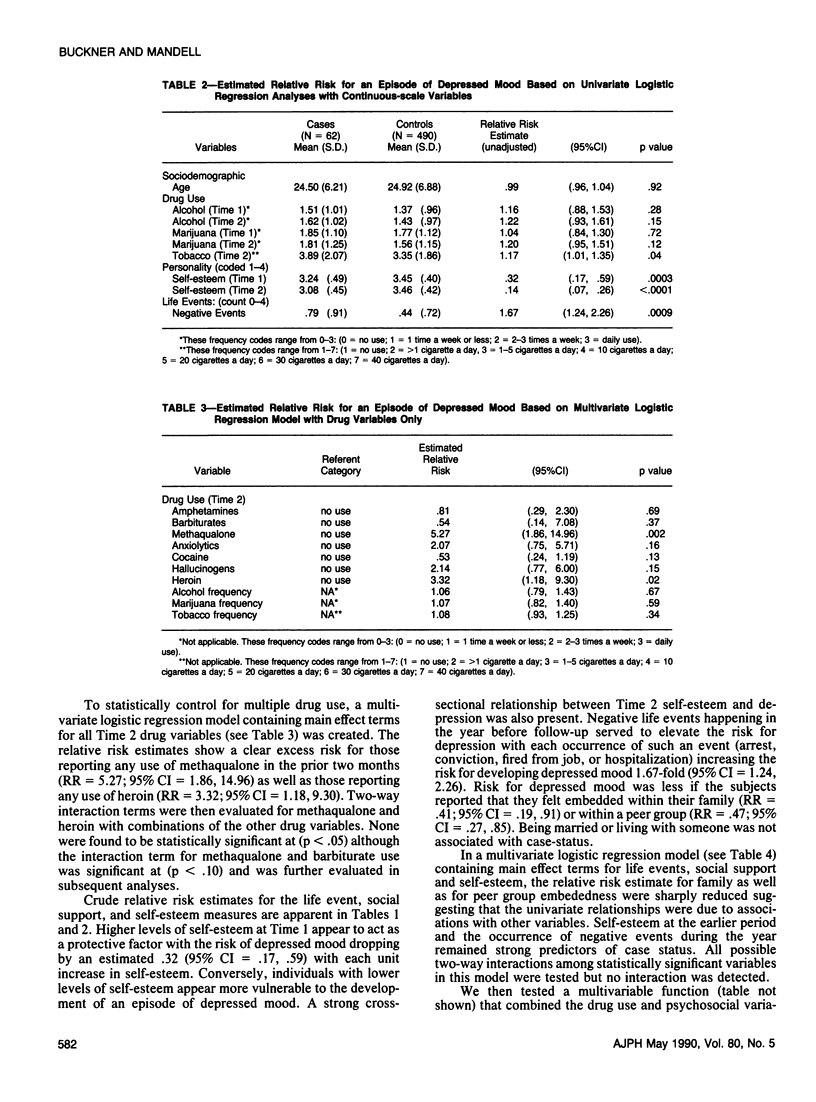
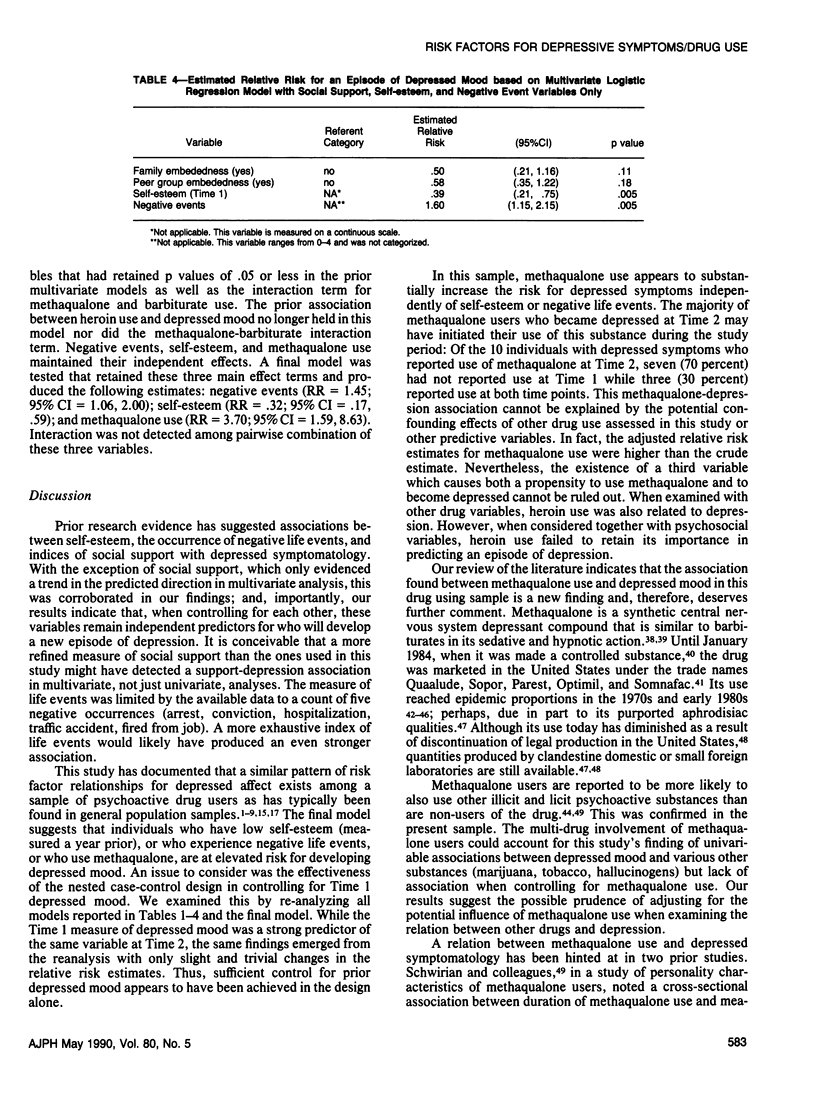
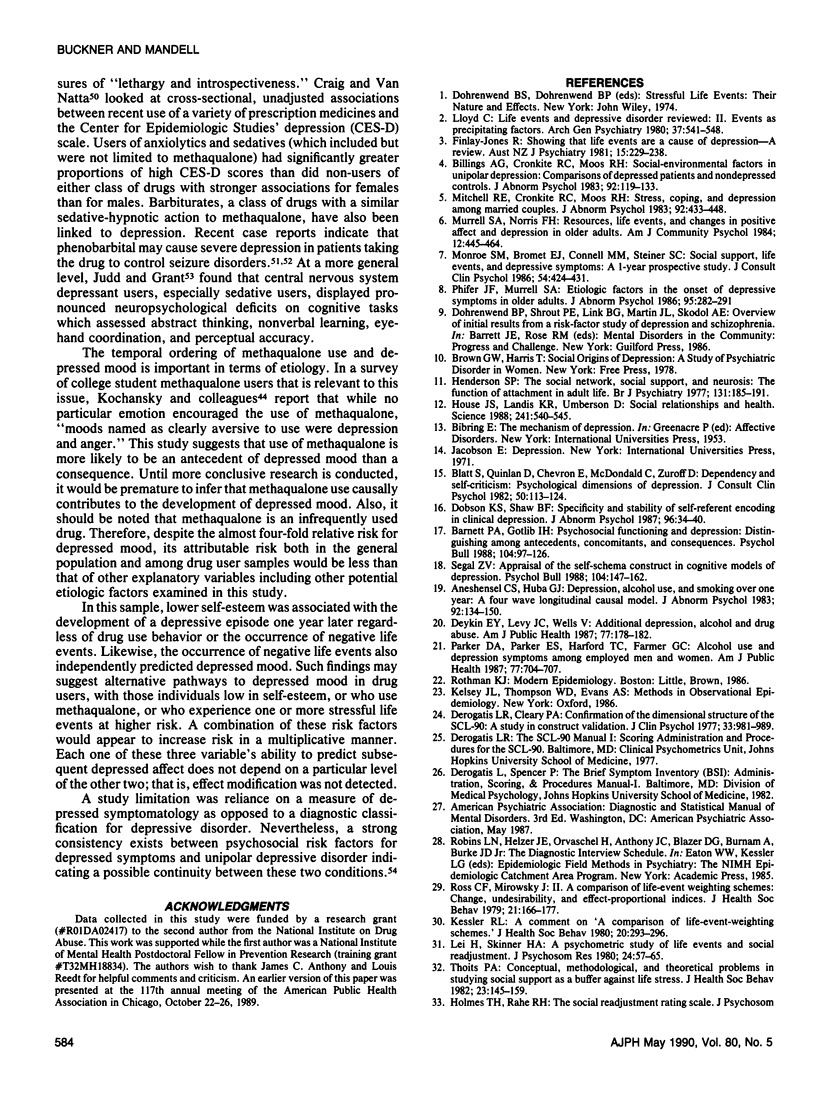
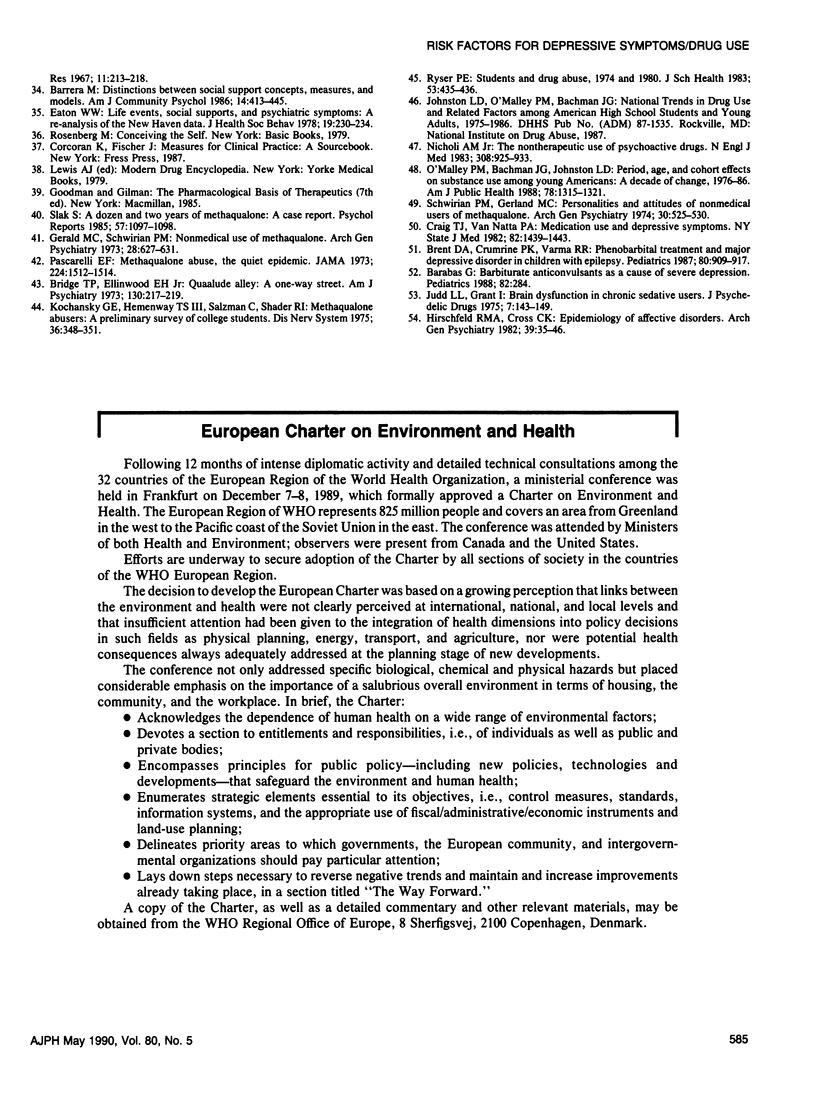
Selected References
These references are in PubMed. This may not be the complete list of references from this article.
- Aneshensel C. S., Huba G. J. Depression, alcohol use, and smoking over one year: a four-wave longitudinal causal model. J Abnorm Psychol. 1983 May;92(2):134–150. doi: 10.1037//0021-843x.92.2.134. [DOI] [PubMed] [Google Scholar]
- Barabas G., Matthews W. S. Barbiturate anticonvulsants as a cause of severe depression. Pediatrics. 1988 Aug;82(2):284–285. [PubMed] [Google Scholar]
- Barnett P. A., Gotlib I. H. Psychosocial functioning and depression: distinguishing among antecedents, concomitants, and consequences. Psychol Bull. 1988 Jul;104(1):97–126. doi: 10.1037/0033-2909.104.1.97. [DOI] [PubMed] [Google Scholar]
- Billings A. G., Cronkite R. C., Moos R. H. Social-environmental factors in unipolar depression: comparisons of depressed patients and nondepressed controls. J Abnorm Psychol. 1983 May;92(2):119–133. doi: 10.1037//0021-843x.92.2.119. [DOI] [PubMed] [Google Scholar]
- Blatt S. J., Quinlan D. M., Chevron E. S., McDonald C., Zuroff D. Dependency and self-criticism: psychological dimensions of depression. J Consult Clin Psychol. 1982 Feb;50(1):113–124. doi: 10.1037//0022-006x.50.1.113. [DOI] [PubMed] [Google Scholar]
- Brent D. A., Crumrine P. K., Varma R. R., Allan M., Allman C. Phenobarbital treatment and major depressive disorder in children with epilepsy. Pediatrics. 1987 Dec;80(6):909–917. [PubMed] [Google Scholar]
- Bridge T. P., Ellinwood E. H., Jr Quaalude alley: a one-way street. Am J Psychiatry. 1973 Feb;130(2):217–219. doi: 10.1176/ajp.130.2.217. [DOI] [PubMed] [Google Scholar]
- Craig T. J., van Natta P. A. Medication use and depressive symptoms. N Y State J Med. 1982 Sep;82(10):1439–1443. [PubMed] [Google Scholar]
- Deykin E. Y., Levy J. C., Wells V. Adolescent depression, alcohol and drug abuse. Am J Public Health. 1987 Feb;77(2):178–182. doi: 10.2105/ajph.77.2.178. [DOI] [PMC free article] [PubMed] [Google Scholar]
- Dobson K. S., Shaw B. F. Specificity and stability of self-referent encoding in clinical depression. J Abnorm Psychol. 1987 Feb;96(1):34–40. doi: 10.1037//0021-843x.96.1.34. [DOI] [PubMed] [Google Scholar]
- Eaton W. W. Life events, social supports, and psychiatric symptoms: a re-analysis of the New Haven data. J Health Soc Behav. 1978 Jun;19(2):230–234. [PubMed] [Google Scholar]
- Finlay-Jones R. Showing that life events are a cause of depression--a review. Aust N Z J Psychiatry. 1981 Sep;15(3):229–238. doi: 10.3109/00048678109159440. [DOI] [PubMed] [Google Scholar]
- Gerald M. C., Schwirian P. M. Nonmedical use of methaqualone. Arch Gen Psychiatry. 1973 May;28(5):627–631. doi: 10.1001/archpsyc.1973.01750350011002. [DOI] [PubMed] [Google Scholar]
- Henderson S. The social network, support and neurosis. The function of attachment in adult life. Br J Psychiatry. 1977 Aug;131:185–191. doi: 10.1192/bjp.131.2.185. [DOI] [PubMed] [Google Scholar]
- Hirschfeld R. M., Cross C. K. Epidemiology of affective disorders. Arch Gen Psychiatry. 1982 Jan;39(1):35–46. doi: 10.1001/archpsyc.1982.04290010013003. [DOI] [PubMed] [Google Scholar]
- House J. S., Landis K. R., Umberson D. Social relationships and health. Science. 1988 Jul 29;241(4865):540–545. doi: 10.1126/science.3399889. [DOI] [PubMed] [Google Scholar]
- Kochansky G. E., Hemenway T. S., 3rd, Salzman C., Shader R. I. Methaqualone abusers: a preliminary survey of college students. Dis Nerv Syst. 1975 Jul;36(7):348–351. [PubMed] [Google Scholar]
- Lei H., Skinner H. A. A psychometric study of life events and social readjustment. J Psychosom Res. 1980;24(2):57–65. doi: 10.1016/0022-3999(80)90054-9. [DOI] [PubMed] [Google Scholar]
- Lloyd C. Life events and depressive disorder reviewed. II. Events as precipitating factors. Arch Gen Psychiatry. 1980 May;37(5):541–548. doi: 10.1001/archpsyc.1980.01780180055005. [DOI] [PubMed] [Google Scholar]
- Mitchell R. E., Cronkite R. C., Moos R. H. Stress, coping, and depression among married couples. J Abnorm Psychol. 1983 Nov;92(4):433–448. doi: 10.1037//0021-843x.92.4.433. [DOI] [PubMed] [Google Scholar]
- Monroe S. M., Bromet E. J., Connell M. M., Steiner S. C. Social support, life events, and depressive symptoms: a 1-year prospective study. J Consult Clin Psychol. 1986 Aug;54(4):424–431. doi: 10.1037//0022-006x.54.4.424. [DOI] [PubMed] [Google Scholar]
- Murrell S. A., Norris F. H. Resources, life events, and changes in positive affect and depression in older adults. Am J Community Psychol. 1984 Aug;12(4):445–464. doi: 10.1007/BF00896505. [DOI] [PubMed] [Google Scholar]
- Nicholi A. M., Jr The nontherapeutic use of psychoactive drugs. A modern epidemic. N Engl J Med. 1983 Apr 21;308(16):925–933. doi: 10.1056/NEJM198304213081604. [DOI] [PubMed] [Google Scholar]
- O'Malley P. M., Bachman J. G., Johnston L. D. Period, age, and cohort effects on substance use among young Americans: a decade of change, 1976-86. Am J Public Health. 1988 Oct;78(10):1315–1321. doi: 10.2105/ajph.78.10.1315. [DOI] [PMC free article] [PubMed] [Google Scholar]
- Parker D. A., Parker E. S., Harford T. C., Farmer G. C. Alcohol use and depression symptoms among employed men and women. Am J Public Health. 1987 Jun;77(6):704–707. doi: 10.2105/ajph.77.6.704. [DOI] [PMC free article] [PubMed] [Google Scholar]
- Pascarelli E. F. Methaqualone abuse, the quiet epidemic. JAMA. 1973 Jun 11;224(11):1512–1514. [PubMed] [Google Scholar]
- Phifer J. F., Murrell S. A. Etiologic factors in the onset of depressive symptoms in older adults. J Abnorm Psychol. 1986 Aug;95(3):282–291. doi: 10.1037//0021-843x.95.3.282. [DOI] [PubMed] [Google Scholar]
- Ross C. E., Mirowsky J., 2nd A comparison of life-event-weighting schemes: change, undesirability, and effect-proportional indices. J Health Soc Behav. 1979 Jun;20(2):166–177. [PubMed] [Google Scholar]
- Ryser P. E. Students and drug abuse, 1974 and 1980. J Sch Health. 1983 Sep;53(7):435–436. doi: 10.1111/j.1746-1561.1983.tb03157.x. [DOI] [PubMed] [Google Scholar]
- Schwirian P. M., Gerland M. C. Personalities and attitudes of nonmedical users of methaqualone. Arch Gen Psychiatry. 1974 Apr;30(4):525–530. doi: 10.1001/archpsyc.1974.01760100087014. [DOI] [PubMed] [Google Scholar]
- Segal Z. V. Appraisal of the self-schema construct in cognitive models of depression. Psychol Bull. 1988 Mar;103(2):147–162. doi: 10.1037/0033-2909.103.2.147. [DOI] [PubMed] [Google Scholar]
- Slak S. A dozen and two years of methaqualone: a case report. Psychol Rep. 1985 Dec;57(3 Pt 2):1097–1098. doi: 10.2466/pr0.1985.57.3f.1097. [DOI] [PubMed] [Google Scholar]
- Thoits P. A. Conceptual, methodological, and theoretical problems in studying social support as a buffer against life stress. J Health Soc Behav. 1982 Jun;23(2):145–159. [PubMed] [Google Scholar]


